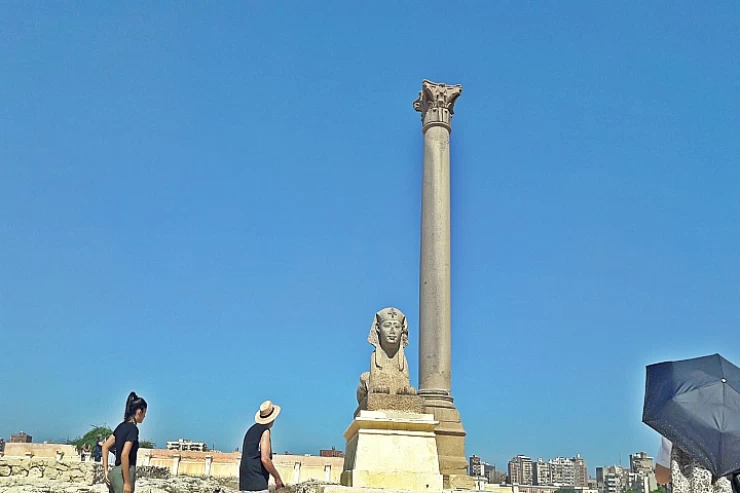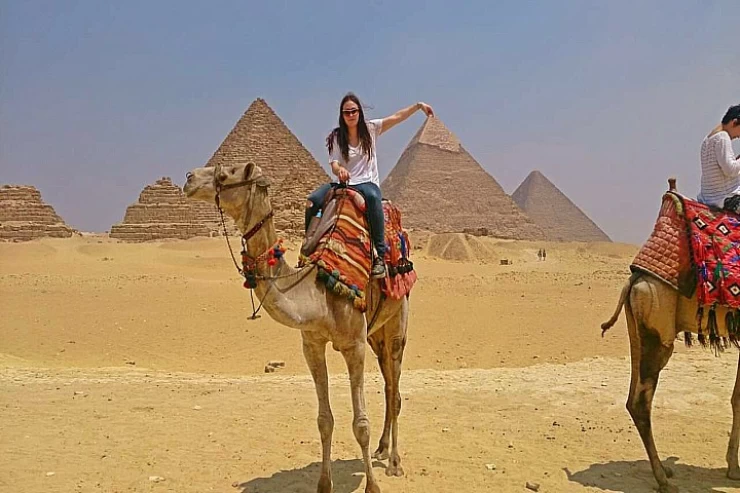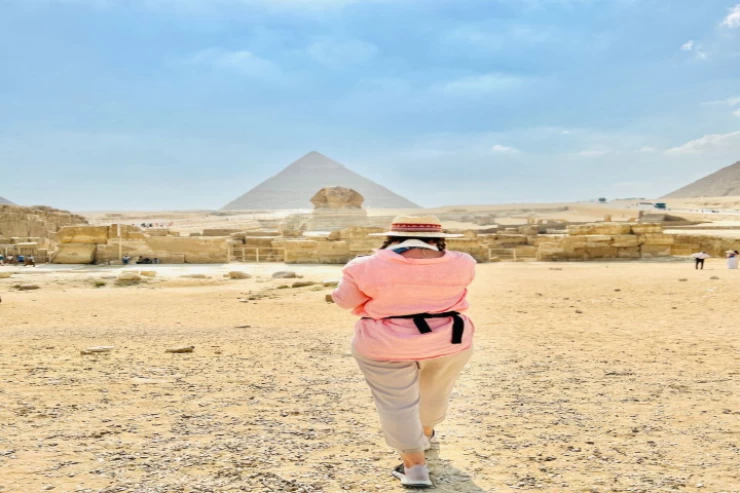
King Khafra
King Khafra
The ancient Egyptians were interested in the other world and resurrection more than anything else, unlike other civilizations; for example, the Greeks left theatres where they were interested in art and literature, and the Romans left stadiums for battles and fights, such as the Colosseum, but the Egyptians were always interested in constructing tombs, believing that they would go to the other world with everything, which made them leave their treasures inside their tombs.
Since ancient times, Egypt has been distinguished by its great architecture, as it is the one in which the pyramids and the lighthouse of Alexandria were built, which were two of the seven wonders of the world. The pharaohs have left us a great civilizational legacy, and among those who wrote this history and made civilization is King Khafre, the son of the great Khufu, the owner of the greatest pyramid in history.
King Khafre was not the king who ruled directly after his father, but his brother ruled for a short period, after which King Khafre's rule began, which reached more than 20 years, with different opinions, as the historian Maniton said that Khafre's rule was over 60 years, but whatever the period in which he ruled, he made achievements that history testifies to as one of the best constructions in the ancient world until this day.
The meaning of this king's name is related to the sun god among the ancient Egyptians, which is the god Ra, as his name is formed from two words, the first is Khaf or Khaaf and the second is Ra, so the meaning of his name is like Ra, that is, he compared himself to the god Ra, and this tradition has always happened that kings consider themselves as gods.
The most common doubt was who his mother was; they did not agree on anyone, as some said that we did not know who his real mother was until now, and others said that Queen Meret Etz I was his mother, who was the wife of Khufu and his son Sneferu, who was buried in the Pyramid of Queens next to the Great Pyramid, but until now there is nothing clear about the identity of King Khafre's mother.
Khafre married more than one wife, who from the first queen had his son, King Menkaure, the owner of the last pyramid in the Giza pyramids, which concluded the historical achievement in the land of Egypt, or Thebes, as they called it in ancient times.
Who was King Khafre's wife?
Queen Khafre was the first wife of King Khafre, and she was also the mother of King Menkaure. Part of her name was discovered written on a stone in the private temple of Menkaure; it is considered a place full of information about this queen, as she was mentioned again on the lintel at the entrance, and this royal mother was discovered by Salim Hassan, but there is controversy and different opinions about whether this tomb is the tomb of Queen Khafre or is it the tomb of another queen.
The Greek historian Herodotus wrote about King Khafre, saying that he was an oppressive king and that he had enslaved the people and hated him, but what we know, and the Egyptian government confirmed, is that he took these words from Egyptian priests who hated King Khafre.
King Khafre's achievements
Middle Pyramid
This pyramid is located near the pyramid of his father on its west, and its height reaches more than 140 meters. It is located on land equal to the level. The main entrance to the pyramid is at the bottom and has a granite roof, and the last entrance to the corridor leads to an empty room. Some say that it is a burial room, but this is not true.
Khafre, like his father, constructed the pyramid in the Giza area, as the solid ground that could support heavy weights was one of the most important elements in building the pyramid, and this is what King Sneferu suffered from, which led to the fall of his first pyramid, and the stones were well polished, which helped them to arrange the stones in their correct form that we see today, and you can imagine that all this beauty was made 5000 years ago; that is, all the discovery of all means that help us build many buildings, so the question always they ask, how the pharaohs built their pyramids?
Some reports suggest that the second pyramid was stolen during the second decay, meaning that it now does not include all the monuments left by the king, but some modern historians say that the pyramids were stolen in previous centuries, as they found Arabic inscriptions on the wall of the burial chamber and other opinions about when and how the second pyramid of King Khafre was stolen or opened.
King Khafre tried to build a pyramid that would be larger than his father's pyramid, as it was constructed on a higher place, and the most special feature of this pyramid is the presence of a large part of its top, unlike the other two pyramids.
Valley Temple
Khafre constructed a mortuary temple that reached the pyramids by a road called the processional route that would take the king from the temple to the pyramid to be buried.
They used the temple to place niches and statues, and the most important thing was to perform funeral rituals, so King Khafre placed it near his pyramid, and they discovered in this temple a large statue of King Khafre that is currently in the Egyptian Museum, and the most unique feature of this pyramid is the presence of the bird that represents the god Horus.
Sphinx
Although opinions varied about whether the Sphinx was originally built by King Khufu or Khafre, the opinion was more in the direction of King Khafre, which has more than one proof. For example, the Sphinx is near the temple of this king, especially on the road leading to the pyramid, and the face of the Sphinx is very similar to the statue of King Khafre, which are reasons enough to say that the Sphinx was constructed by the king of the Middle Pyramid.
As for his name, the ancient Egyptian name is completely different from the current name, as the hieroglyphic name for him meant the horizon of Horus, but the name he has now is Sphinx, which came from Greek mythology.
It is no wonder that King Khafre is one of the most brilliant Egyptian kings in history and one of the most important kings of the Old Kingdom, who built two of the most magnificent works in history, so I think that this king is no less great than his father and the rest of the pharaohs' kings.
King Chephren, son of Cheops:
He is the second reigning son of King Cheops, who returned to the Giza Necropolis to build the second biggest pyramid. You can view it fully from various angles during the tour of the Giza Pyramids; this gigantic structure is unfortunately overshadowed by the work of his father.
Even if the Pyramid of Khafra is smaller than the Great Pyramid of Khufu, it appears taller, as it was erected at a higher location. Originally, it had a height of 143.5 m (471 ft), and it still preserves some of its original casing stones on the tip of the pyramid, providing a view of how these pyramids would have appeared to the people of antiquity. This kingdom consists of a well-maintained Valley Temple, where amazing diorite statues of Khafra were found.
King Chephren of the fourth dynasty of the Old Kingdom in ancient Egypt ruled after his elder brother Djedefre, who built his pyramid in Abo Rawash apparently around 2570 B.C. He assumed power for more than twenty years (almost 26 years) and was succeeded by his son, the builder of the last pyramid in Giza, Mycerinus.
During the reign of Chephren, sculpture made significant progress, so although many of his statues have already been recycled in antiquity, we still have several images of this powerful and self-confident ruler. However, it is thanks to the face of the sphinx that Chephren is universally known. The Sphinx, with its lion body and man's head, which was supposed to depict the symbols of royalty and the sun, was carved into the living rock to stand guard along the ramp leading to the pyramid of Khafre; he was known to be a firm ruler. He closed down many of the temples in Egypt, following the trend started by his father, King Cheops.
The pyramid of Chephren was destined to be the last of the great pyramids. His son and heir, Mycerinus, was satisfied with a decidedly less imposing construction; his pyramid is about a tenth of that of his grandfather and is only 66 meters high. Without worrying about how to understand the key terms of Egyptian history, we will see an Egyptologist guide, who will meet your expectations.


















